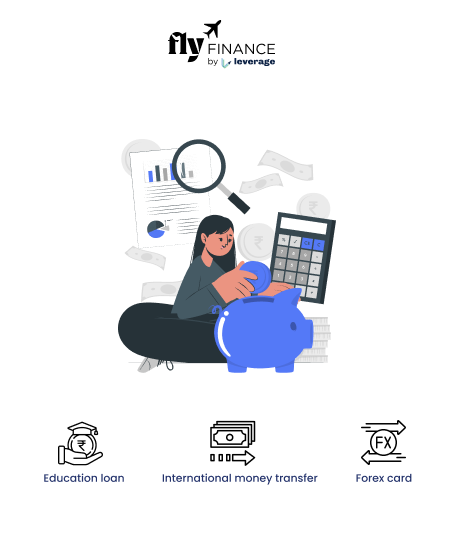Financial support plays a pivotal role in facilitating a student’s educational journey. Beyond tuition expenses, there are various other aspects such as books, extracurricular activities and social engagements that necessitate financial consideration. While loans can provide some assistance, they may fall short of addressing all of a student’s essential needs. However, a specialised student line of credit offers a range of advantages when seeking financial aid. The following blog provides an in-depth understanding of this topic, catering to discerning readers who seek comprehensive knowledge in this domain.
What is a Student Line of Credit?
In essence, a line of credit entails a predetermined funding limit that allows students to borrow and repay as needed. The credit limit can vary based on several factors, typically ranging from $5000 to $80,000 (INR 4 Lakh – 65 Lakh) or more. This financial resource holds significant importance for students pursuing their education, as it can be utilised to cover tuition fees, textbooks, appliances, and daily expenses. Notably, if a student borrows $10,000 (INR 8 Lakh) through a line of credit, they can continually access and utilise the entire $10,000 (INR 8 Lakh) with the requirement of timely repayment. An additional advantage of an educational line of credit is that interest fees are levied solely on the borrowed amount, rather than the initial offered sum.
Also read: How to Pay Off Student Loans?
Process of Repayment
Let us take a look at the process of repayment:
- Similar to funds borrowed from any financial institution, the borrower is obliged to repay the borrowed amount.
- When availing of a student line of credit, the borrower is only required to make interest payments while they are enrolled in college or university.
- The lenders may also provide an option to pay only the interest for a period of 6 to 12 months after graduation, following which the entire borrowed amount, along with accrued interest, must be repaid.
- It is crucial to repay these funds in a timely manner as it can have a significant impact on your credit score in the future.
Accessing Money from a Student Line of Credit
Once you have completed all the required paperwork and your application for a student line of credit is approved, you will have immediate access to the available credit. There are several methods through which you can access the funds:
- Visiting a branch of your financial institution
- Using an ATM, or utilising online
- Mobile or telephone banking services.
- Writing a cheque to access the credit is less common but still an option.
It is important to borrow only the necessary amount to cover your educational expenses and consider your ability to make interest payments while studying. It is wise to carefully consider your repayment ability upon graduation before borrowing from the line of credit.
Also read: Best Ways to Use Credit Cards for College Student
A Comparison of Student Line of Credit and Student Loans
When comparing student lines of credit and student loans, there are a few key factors to consider:
- Student lines of credit offer flexibility in borrowing and deferred payments while in college, with lower interest rates on the borrowed amount.
- However, they may have higher overall interest rates and lack specific loan purposes. Student loans generally have lower interest rates, but the interest is charged on the full loan amount and may require payments during college.
It’s crucial to carefully evaluate these pros and cons before choosing the most suitable option.
Pros
- Student loans provide the means to afford college.
- Student loans can make attending your dream school possible.
- Student loans can be used for various educational expenses.
- Paying off student loans helps build credit.
Cons
- Student loans can be expensive.
- Student loans result in starting life with debt.
- Repaying student loans may delay other life goals.
- Defaulting on student loans can severely damage your credit score.
- Student loans can become burdensome if unable to pay.
Student Line of Credit Benefits:
Given below are the benefits of students’ line of credit:
- Borrowing flexibility: Students can borrow funds as needed, and the borrowed amount can be recycled if repaid promptly.
- Interest on borrowed amount: Interest is charged only on the amount borrowed, allowing students to borrow only what they require.
- Versatile use of funds: Students can use the funds for various essential expenses related to their education.
- Build credit history: Timely repayment of the line of credit can help students establish a positive credit history.
Also read: Best Private Student Loans without Cosigner
Student Line of Credit with Calculator:
When considering a line of credit or student loans, using a financial calculator can be beneficial. A financial calculator allows students to input relevant details such as interest rates, loan amounts and repayment terms to calculate the estimated cost of borrowing. This helps students make informed decisions by comparing the total repayment amounts for different options. By utilising a financial calculator, students can gain a clear understanding of the financial implications and choose the option that best suits their needs and budget.
Advantages
Take a look at the advantages of a student line of credit without a cosigner:
- Independence: Students can secure funds independently without relying on a cosigner’s credit history.
- Flexibility: Borrowers have the flexibility to access funds as needed, up to the approved credit limit.
- Competitive Interest Rates: Student lines of credit typically offer competitive interest rates, resulting in lower interest costs.
- Repayment Options: Many lenders provide flexible repayment options, including interest-only payments during the study period and deferred principal repayment until after graduation.
A student line of credit offers a valuable financial solution for students pursuing higher education. It provides the independence and flexibility to access funds as needed, as these are loans without a cosigner. With competitive interest rates and flexible repayment options, students can manage their expenses effectively and focus on their studies. However, it’s essential to carefully consider the terms and conditions, as well as assess one’s financial capabilities before opting for a line of credit.
FAQs
Ans. Interest rates for student lines of credit vary among different banks. Some factors considered include the duration and type of course, employment status, etc. Others may offer rates based on the prime rate with additional percentages.
Ans. General eligibility criteria typically include being enrolled in a university or college, being of legal age, and being either a Canadian resident or a permanent resident.
Ans. Student lines of credit are available at banks or credit unions, making them ideal places to apply. A brief eligibility check can determine your chances of receiving a student line of credit.
Ans. While student lines of credit are primarily available to Canadian residents or permanent residents, some financial institutions may offer options for international students. It is advisable to inquire with various banks or credit unions to explore potential opportunities for international students.
In case you need further guidance on student financing options or assistance with your study abroad plans, you can reach out to the experts at Fly. Finance. With their extensive knowledge and experience, we can provide personalised advice and support to help you make informed decisions about your education journey.



























